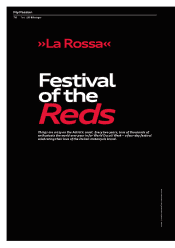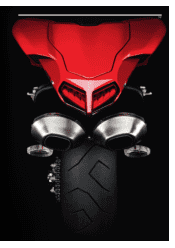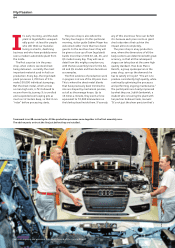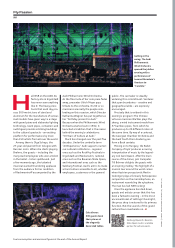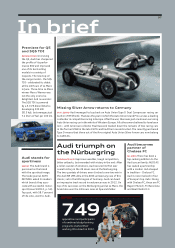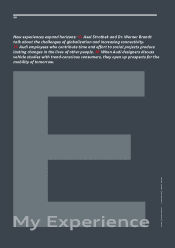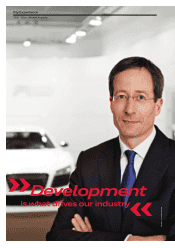Audi 2012 Annual Report Download - page 89
Download and view the complete annual report
Please find page 89 of the 2012 Audi annual report below. You can navigate through the pages in the report by either clicking on the pages listed below, or by using the keyword search tool below to find specific information within the annual report.
Framing
In a clamping frame, the sub -
structure is rst joined to the
internal side panels before the
exterior side panels and roof
frame are added. Altogether,
more than 1,600 robots are
used in the body shop.
Preparing for assembly
Before further items are
added to the body, the doors
are removed and various
protective covers and the
data carriers attached.
The “supermarket”
Where such a large number of
dierent cars are built, the logistic
systems have to be very ingenious.
The “supermarket” is where the
incoming ow of materials is made
ready for the assembly lines.
Employees ll bins with
the parts that have to
reach the assembly lines
exactly when they are
needed.
After the engine, transmission,
gear shift, exhaust system and
fuel tank have been installed,
the chassis is complete.
Chassis assembly
takes place parallel
to the main
assembly line.
Laser and ultrasonic testing
The body dimensions are checked
by laser sensors and the strength
of the spot welds is checked by non-
destructive ultrasonic means.
Basecoat
The basecoat is applied by dip
coating. The body is immersed
in a vat of paint, and rotates
around its transverse axis.
The vat is electrically charged;
the positively charged paint
particles are attracted onto
the negatively charged sheet
metal, and cover all the
surfaces uniformly.
Filler, topcoat and clear lacquer
Robots distribute the paint layers
uniformly over the body at high
pressure. Their nozzles can be switched
over to a dierent color within ten
seconds.
Pre-assembly
As the car begins to take shape on the
assembly line, the suspension, driver’s
cockpit and various other components
are being pre-assembled on the ground
oor. They will be moved to the assembly
line at precisely the right moment. Here,
for instance, the doors have their windows,
locks and airbags added.
Wiring harness
Final assembly starts with the
installation of the wiring harness
and all the necessary cables.
After pre-assembly on
the ground oor,
these items are brought
up by elevator to the
assembly area.
Drying the body
After each coat of paint the
bodies are dried in special
ovens at temperatures up to
185 degrees.
Ergonomic
assembly seat (EMS)
The EMS makes assembly
work on the interior of
the car much easier.
The employee gets into
the seat, which then
moves to a convenient
point inside. Items
of equipment can then
be installed safely
and quickly.
Installing the
driver’s area
The pre-assembled dash
panel, the heating and
the pedal assembly are
brought to the assembly
point. Like other items
of considerable weight,
a hoist lifts them into
the car.
The “marriage”
This is where the body
and chassis come
together and are joined
using more than 50
threaded connections.
Front-end module
The front-end pre-
assembly includes the
headlights, the cooling
system and also the
crash module.
Roller test rig
After the engine has been
started for the rst time,
the car’s behavior on various
types of surface is checked.
Interior trim
The wheels and bumpers
come next, then the
interior trim and seats.
Finally, the doors are
re-attached.
Leak testing
After checking the electronics,
the car undergoes a leak
test to make sure that it is
watertight.
Ready for delivery!
The vehicles are then loaded
onto trains or trucks for
delivery to Audi customers,
or they can choose to collect
their car from the plant.
Final inspection
Now we come to “check-
point 8,” the nal inspection,
where the quality assur ance
teams give the car a last
careful check. Their experi-
ence allows them to
detect even the slightest
shortcomings.
AUDI AG –
Ingolstadt plant
The main location
occupies a site area of
2.7 million square meters
– roughly equal to the
Principality of Monaco.
Paint coating
The paint coating is one tenth of
a millimeter thick, no more
than a human hair. After a zinc
phosphate layer that increases
paint adhesion and protects
the body against corrosion, about
4.5 kilograms of topcoat are
applied. Water-based paints
with a low proportion of solvents
are used.
High-speed rotary
bell sprayer
The spray heads on the paint-
ing robots rotate at up to
45,000 revolutions per minute
to atomize the paint. The
nger-like projections have a
positive, the body a negative
electrical charge. This attracts
the paint to the body, which
is grounded, and avoids losses
due to overspraying.
After the body is
degreased and its
doors, hood and trunk
lid are attached,
conveyors then move
it to the paint shop.
Coils
Coils
Galvanized sheet
steel for the
bodies is delivered
as coils weighing
up to 35 tons.
Blank-cutting tools
Stamped-out blanks
Calibrating ball
Robot with laser
measuring device
Cutting and stamping machines
Before production starts, the coils
are unrolled. The sheet steel is
trimmed into two-dimensional
blanks of suitable size and shape.
Blank
Suitable shapes are
stamped out of
the two-dimensional
blanks before they
enter the press.
Press shop
The plant’s 18 press lines
process 1,700 tons of
sheet steel every day, and
produce 530,000 individual
elements.
Press tools
Driverless transport
systems move the
stamped-out blanks
to the press shop.
Platform
Robots with welding tongs
rst join the front and rear
oors and wheel arches so
that the substructure begins
to take shape.
Direct
store for
stampings
Moving
stampings to
the body shop.
On the press line the blanks are shaped into nished body elements in a
series of work stages and at pressures of approximately 70,000 kilonewtons.
Wheels
The wheels and
tires, which Audi
doesn’t manufacture
itself, are pre-assembled
close to the factory
site, and delivered when
they are needed on the
assembly lines.
Removing the doors
Data carrier
Production orderProtective covers
Welding tongs
Basecoat
Clear lacquer
Topcoat
Filler
Zinc phosphate coating
Sheet steel
Steps 1to6
Tire casing
Belt layer Tread
Belt edge
protection
1
2
3
4
5
Paint Shop
Technical
Development
Press Shop North
Assembly Body Shop
Toolmaking
Testing/Assembly
Paint Shop
Stamping and Press Shop
1
2
3
4
5
Final Assembly
Chassis assembly
Testing
How an Audi
takes shape
Body Shop
The whole process starts with sheet metal.
By the end, a complete new Audi has
taken shape. The Ingolstadt plant employs
more than 35,000 people. They work
three shifts and build more than 2,500
A3, A4, A5, and Q5 cars every day.
i l l u s t r at i o n | c h r i s t i a n e i s e n b e r g
Framing
In a clamping frame, the sub -
structure is rst joined to the
internal side panels before the
exterior side panels and roof
frame are added. Altogether,
more than 1,600 robots are
used in the body shop.
Preparing for assembly
Before further items are
added to the body, the doors
are removed and various
protective covers and the
data carriers attached.
The “supermarket”
Where such a large number of
dierent cars are built, the logistic
systems have to be very ingenious.
The “supermarket” is where the
incoming ow of materials is made
ready for the assembly lines.
Employees ll bins with
the parts that have to
reach the assembly lines
exactly when they are
needed.
After the engine, transmission,
gear shift, exhaust system and
fuel tank have been installed,
the chassis is complete.
Chassis assembly
takes place parallel
to the main
assembly line.
Laser and ultrasonic testing
The body dimensions are checked
by laser sensors and the strength
of the spot welds is checked by non-
destructive ultrasonic means.
Basecoat
The basecoat is applied by dip
coating. The body is immersed
in a vat of paint, and rotates
around its transverse axis.
The vat is electrically charged;
the positively charged paint
particles are attracted onto
the negatively charged sheet
metal, and cover all the
surfaces uniformly.
Filler, topcoat and clear lacquer
Robots distribute the paint layers
uniformly over the body at high
pressure. Their nozzles can be switched
over to a dierent color within ten
seconds.
Pre-assembly
As the car begins to take shape on the
assembly line, the suspension, driver’s
cockpit and various other components
are being pre-assembled on the ground
oor. They will be moved to the assembly
line at precisely the right moment. Here,
for instance, the doors have their windows,
locks and airbags added.
Wiring harness
Final assembly starts with the
installation of the wiring harness
and all the necessary cables.
After pre-assembly on
the ground oor,
these items are brought
up by elevator to the
assembly area.
Drying the body
After each coat of paint the
bodies are dried in special
ovens at temperatures up to
185 degrees.
Ergonomic
assembly seat (EMS)
The EMS makes assembly
work on the interior of
the car much easier.
The employee gets into
the seat, which then
moves to a convenient
point inside. Items
of equipment can then
be installed safely
and quickly.
Installing the
driver’s area
The pre-assembled dash
panel, the heating and
the pedal assembly are
brought to the assembly
point. Like other items
of considerable weight,
a hoist lifts them into
the car.
The “marriage”
This is where the body
and chassis come
together and are joined
using more than 50
threaded connections.
Front-end module
The front-end pre-
assembly includes the
headlights, the cooling
system and also the
crash module.
Roller test rig
After the engine has been
started for the rst time,
the car’s behavior on various
types of surface is checked.
Interior trim
The wheels and bumpers
come next, then the
interior trim and seats.
Finally, the doors are
re-attached.
Leak testing
After checking the electronics,
the car undergoes a leak
test to make sure that it is
watertight.
Ready for delivery!
The vehicles are then loaded
onto trains or trucks for
delivery to Audi customers,
or they can choose to collect
their car from the plant.
Final inspection
Now we come to “check-
point 8,” the nal inspection,
where the quality assur ance
teams give the car a last
careful check. Their experi-
ence allows them to
detect even the slightest
shortcomings.
AUDI AG –
Ingolstadt plant
The main location
occupies a site area of
2.7 million square meters
– roughly equal to the
Principality of Monaco.
Paint coating
The paint coating is one tenth of
a millimeter thick, no more
than a human hair. After a zinc
phosphate layer that increases
paint adhesion and protects
the body against corrosion, about
4.5 kilograms of topcoat are
applied. Water-based paints
with a low proportion of solvents
are used.
High-speed rotary
bell sprayer
The spray heads on the paint-
ing robots rotate at up to
45,000 revolutions per minute
to atomize the paint. The
nger-like projections have a
positive, the body a negative
electrical charge. This attracts
the paint to the body, which
is grounded, and avoids losses
due to overspraying.
After the body is
degreased and its
doors, hood and trunk
lid are attached,
conveyors then move
it to the paint shop.
Coils
Coils
Galvanized sheet
steel for the
bodies is delivered
as coils weighing
up to 35 tons.
Blank-cutting tools
Stamped-out blanks
Calibrating ball
Robot with laser
measuring device
Cutting and stamping machines
Before production starts, the coils
are unrolled. The sheet steel is
trimmed into two-dimensional
blanks of suitable size and shape.
Blank
Suitable shapes are
stamped out of
the two-dimensional
blanks before they
enter the press.
Press shop
The plant’s 18 press lines
process 1,700 tons of
sheet steel every day, and
produce 530,000 individual
elements.
Press tools
Driverless transport
systems move the
stamped-out blanks
to the press shop.
Platform
Robots with welding tongs
rst join the front and rear
oors and wheel arches so
that the substructure begins
to take shape.
Direct
store for
stampings
Moving
stampings to
the body shop.
On the press line the blanks are shaped into nished body elements in a
series of work stages and at pressures of approximately 70,000 kilonewtons.
Wheels
The wheels and
tires, which Audi
doesn’t manufacture
itself, are pre-assembled
close to the factory
site, and delivered when
they are needed on the
assembly lines.
Removing the doors
Data carrier
Production orderProtective covers
Welding tongs
Basecoat
Clear lacquer
Topcoat
Filler
Zinc phosphate coating
Sheet steel
Steps 1to6
Tire casing
Belt layer Tread
Belt edge
protection
1
2
3
4
5
Paint Shop
Technical
Development
Press Shop North
Assembly Body Shop
Toolmaking
Testing/Assembly
Paint Shop
Stamping and Press Shop
1
2
3
4
5
Final Assembly
Chassis assembly
Testing
How an Audi
takes shape
Body Shop
The whole process starts with sheet metal.
By the end, a complete new Audi has
taken shape. The Ingolstadt plant employs
more than 35,000 people. They work
three shifts and build more than 2,500
A3, A4, A5, and Q5 cars every day.
i l l u s t r at i o n | c h r i s t i a n e i s e n b e r g
Framing
In a clamping frame, the sub -
structure is rst joined to the
internal side panels before the
exterior side panels and roof
frame are added. Altogether,
more than 1,600 robots are
used in the body shop.
Preparing for assembly
Before further items are
added to the body, the doors
are removed and various
protective covers and the
data carriers attached.
The “supermarket”
Where such a large number of
dierent cars are built, the logistic
systems have to be very ingenious.
The “supermarket” is where the
incoming ow of materials is made
ready for the assembly lines.
Employees ll bins with
the parts that have to
reach the assembly lines
exactly when they are
needed.
After the engine, transmission,
gear shift, exhaust system and
fuel tank have been installed,
the chassis is complete.
Chassis assembly
takes place parallel
to the main
assembly line.
Laser and ultrasonic testing
The body dimensions are checked
by laser sensors and the strength
of the spot welds is checked by non-
destructive ultrasonic means.
Basecoat
The basecoat is applied by dip
coating. The body is immersed
in a vat of paint, and rotates
around its transverse axis.
The vat is electrically charged;
the positively charged paint
particles are attracted onto
the negatively charged sheet
metal, and cover all the
surfaces uniformly.
Filler, topcoat and clear lacquer
Robots distribute the paint layers
uniformly over the body at high
pressure. Their nozzles can be switched
over to a dierent color within ten
seconds.
Pre-assembly
As the car begins to take shape on the
assembly line, the suspension, driver’s
cockpit and various other components
are being pre-assembled on the ground
oor. They will be moved to the assembly
line at precisely the right moment. Here,
for instance, the doors have their windows,
locks and airbags added.
Wiring harness
Final assembly starts with the
installation of the wiring harness
and all the necessary cables.
After pre-assembly on
the ground oor,
these items are brought
up by elevator to the
assembly area.
Drying the body
After each coat of paint the
bodies are dried in special
ovens at temperatures up to
185 degrees.
Ergonomic
assembly seat (EMS)
The EMS makes assembly
work on the interior of
the car much easier.
The employee gets into
the seat, which then
moves to a convenient
point inside. Items
of equipment can then
be installed safely
and quickly.
Installing the
driver’s area
The pre-assembled dash
panel, the heating and
the pedal assembly are
brought to the assembly
point. Like other items
of considerable weight,
a hoist lifts them into
the car.
The “marriage”
This is where the body
and chassis come
together and are joined
using more than 50
threaded connections.
Front-end module
The front-end pre-
assembly includes the
headlights, the cooling
system and also the
crash module.
Roller test rig
After the engine has been
started for the rst time,
the car’s behavior on various
types of surface is checked.
Interior trim
The wheels and bumpers
come next, then the
interior trim and seats.
Finally, the doors are
re-attached.
Leak testing
After checking the electronics,
the car undergoes a leak
test to make sure that it is
watertight.
Ready for delivery!
The vehicles are then loaded
onto trains or trucks for
delivery to Audi customers,
or they can choose to collect
their car from the plant.
Final inspection
Now we come to “check-
point 8,” the nal inspection,
where the quality assur ance
teams give the car a last
careful check. Their experi-
ence allows them to
detect even the slightest
shortcomings.
AUDI AG –
Ingolstadt plant
The main location
occupies a site area of
2.7 million square meters
– roughly equal to the
Principality of Monaco.
Paint coating
The paint coating is one tenth of
a millimeter thick, no more
than a human hair. After a zinc
phosphate layer that increases
paint adhesion and protects
the body against corrosion, about
4.5 kilograms of topcoat are
applied. Water-based paints
with a low proportion of solvents
are used.
High-speed rotary
bell sprayer
The spray heads on the paint-
ing robots rotate at up to
45,000 revolutions per minute
to atomize the paint. The
nger-like projections have a
positive, the body a negative
electrical charge. This attracts
the paint to the body, which
is grounded, and avoids losses
due to overspraying.
After the body is
degreased and its
doors, hood and trunk
lid are attached,
conveyors then move
it to the paint shop.
Coils
Coils
Galvanized sheet
steel for the
bodies is delivered
as coils weighing
up to 35 tons.
Blank-cutting tools
Stamped-out blanks
Calibrating ball
Robot with laser
measuring device
Cutting and stamping machines
Before production starts, the coils
are unrolled. The sheet steel is
trimmed into two-dimensional
blanks of suitable size and shape.
Blank
Suitable shapes are
stamped out of
the two-dimensional
blanks before they
enter the press.
Press shop
The plant’s 18 press lines
process 1,700 tons of
sheet steel every day, and
produce 530,000 individual
elements.
Press tools
Driverless transport
systems move the
stamped-out blanks
to the press shop.
Platform
Robots with welding tongs
rst join the front and rear
oors and wheel arches so
that the substructure begins
to take shape.
Direct
store for
stampings
Moving
stampings to
the body shop.
On the press line the blanks are shaped into nished body elements in a
series of work stages and at pressures of approximately 70,000 kilonewtons.
Wheels
The wheels and
tires, which Audi
doesn’t manufacture
itself, are pre-assembled
close to the factory
site, and delivered when
they are needed on the
assembly lines.
Removing the doors
Data carrier
Production orderProtective covers
Welding tongs
Basecoat
Clear lacquer
Topcoat
Filler
Zinc phosphate coating
Sheet steel
Steps 1to6
Tire casing
Belt layer Tread
Belt edge
protection
1
2
3
4
5
Paint Shop
Technical
Development
Press Shop North
Assembly Body Shop
Toolmaking
Testing/Assembly
Paint Shop
Stamping and Press Shop
1
2
3
4
5
Final Assembly
Chassis assembly
Testing
How an Audi
takes shape
Body Shop
The whole process starts with sheet metal.
By the end, a complete new Audi has
taken shape. The Ingolstadt plant employs
more than 35,000 people. They work
three shifts and build more than 2,500
A3, A4, A5, and Q5 cars every day.
i l l u s t r at i o n | c h r i s t i a n e i s e n b e r g
Framing
In a clamping frame, the sub -
structure is rst joined to the
internal side panels before the
exterior side panels and roof
frame are added. Altogether,
more than 1,600 robots are
used in the body shop.
Preparing for assembly
Before further items are
added to the body, the doors
are removed and various
protective covers and the
data carriers attached.
The “supermarket”
Where such a large number of
dierent cars are built, the logistic
systems have to be very ingenious.
The “supermarket” is where the
incoming ow of materials is made
ready for the assembly lines.
Employees ll bins with
the parts that have to
reach the assembly lines
exactly when they are
needed.
After the engine, transmission,
gear shift, exhaust system and
fuel tank have been installed,
the chassis is complete.
Chassis assembly
takes place parallel
to the main
assembly line.
Laser and ultrasonic testing
The body dimensions are checked
by laser sensors and the strength
of the spot welds is checked by non-
destructive ultrasonic means.
Basecoat
The basecoat is applied by dip
coating. The body is immersed
in a vat of paint, and rotates
around its transverse axis.
The vat is electrically charged;
the positively charged paint
particles are attracted onto
the negatively charged sheet
metal, and cover all the
surfaces uniformly.
Filler, topcoat and clear lacquer
Robots distribute the paint layers
uniformly over the body at high
pressure. Their nozzles can be switched
over to a dierent color within ten
seconds.
Pre-assembly
As the car begins to take shape on the
assembly line, the suspension, driver’s
cockpit and various other components
are being pre-assembled on the ground
oor. They will be moved to the assembly
line at precisely the right moment. Here,
for instance, the doors have their windows,
locks and airbags added.
Wiring harness
Final assembly starts with the
installation of the wiring harness
and all the necessary cables.
After pre-assembly on
the ground oor,
these items are brought
up by elevator to the
assembly area.
Drying the body
After each coat of paint the
bodies are dried in special
ovens at temperatures up to
185 degrees.
Ergonomic
assembly seat (EMS)
The EMS makes assembly
work on the interior of
the car much easier.
The employee gets into
the seat, which then
moves to a convenient
point inside. Items
of equipment can then
be installed safely
and quickly.
Installing the
driver’s area
The pre-assembled dash
panel, the heating and
the pedal assembly are
brought to the assembly
point. Like other items
of considerable weight,
a hoist lifts them into
the car.
The “marriage”
This is where the body
and chassis come
together and are joined
using more than 50
threaded connections.
Front-end module
The front-end pre-
assembly includes the
headlights, the cooling
system and also the
crash module.
Roller test rig
After the engine has been
started for the rst time,
the car’s behavior on various
types of surface is checked.
Interior trim
The wheels and bumpers
come next, then the
interior trim and seats.
Finally, the doors are
re-attached.
Leak testing
After checking the electronics,
the car undergoes a leak
test to make sure that it is
watertight.
Ready for delivery!
The vehicles are then loaded
onto trains or trucks for
delivery to Audi customers,
or they can choose to collect
their car from the plant.
Final inspection
Now we come to “check-
point 8,” the nal inspection,
where the quality assur ance
teams give the car a last
careful check. Their experi-
ence allows them to
detect even the slightest
shortcomings.
AUDI AG –
Ingolstadt plant
The main location
occupies a site area of
2.7 million square meters
– roughly equal to the
Principality of Monaco.
Paint coating
The paint coating is one tenth of
a millimeter thick, no more
than a human hair. After a zinc
phosphate layer that increases
paint adhesion and protects
the body against corrosion, about
4.5 kilograms of topcoat are
applied. Water-based paints
with a low proportion of solvents
are used.
High-speed rotary
bell sprayer
The spray heads on the paint-
ing robots rotate at up to
45,000 revolutions per minute
to atomize the paint. The
nger-like projections have a
positive, the body a negative
electrical charge. This attracts
the paint to the body, which
is grounded, and avoids losses
due to overspraying.
After the body is
degreased and its
doors, hood and trunk
lid are attached,
conveyors then move
it to the paint shop.
Coils
Coils
Galvanized sheet
steel for the
bodies is delivered
as coils weighing
up to 35 tons.
Blank-cutting tools
Stamped-out blanks
Calibrating ball
Robot with laser
measuring device
Cutting and stamping machines
Before production starts, the coils
are unrolled. The sheet steel is
trimmed into two-dimensional
blanks of suitable size and shape.
Blank
Suitable shapes are
stamped out of
the two-dimensional
blanks before they
enter the press.
Press shop
The plant’s 18 press lines
process 1,700 tons of
sheet steel every day, and
produce 530,000 individual
elements.
Press tools
Driverless transport
systems move the
stamped-out blanks
to the press shop.
Platform
Robots with welding tongs
rst join the front and rear
oors and wheel arches so
that the substructure begins
to take shape.
Direct
store for
stampings
Moving
stampings to
the body shop.
On the press line the blanks are shaped into nished body elements in a
series of work stages and at pressures of approximately 70,000 kilonewtons.
Wheels
The wheels and
tires, which Audi
doesn’t manufacture
itself, are pre-assembled
close to the factory
site, and delivered when
they are needed on the
assembly lines.
Removing the doors
Data carrier
Production orderProtective covers
Welding tongs
Basecoat
Clear lacquer
Topcoat
Filler
Zinc phosphate coating
Sheet steel
Steps 1to6
Tire casing
Belt layer Tread
Belt edge
protection
1
2
3
4
5
Paint Shop
Technical
Development
Press Shop North
Assembly Body Shop
Toolmaking
Testing/Assembly
Paint Shop
Stamping and Press Shop
1
2
3
4
5
Final Assembly
Chassis assembly
Testing
How an Audi
takes shape
Body Shop
The whole process starts with sheet metal.
By the end, a complete new Audi has
taken shape. The Ingolstadt plant employs
more than 35,000 people. They work
three shifts and build more than 2,500
A3, A4, A5, and Q5 cars every day.
i l l u s t r at i o n | c h r i s t i a n e i s e n b e r g


